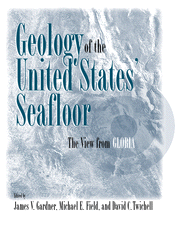Book contents
- Frontmatter
- Contents
- Contributors
- Foreword
- Introduction
- Part I The GLORIA System and Data Processing
- 1 The USGS GLORIA System
- 2 Processing and Manipulating GLORIA Sidescan Sonar Images
- Part II U. S. East Coast EEZ
- Part III Gulf of Mexico and Caribbean EEZ
- Part IV U. S. West Coast EEZ
- Part V Alaskan EEZ
- Index
1 - The USGS GLORIA System
Published online by Cambridge University Press: 25 January 2010
- Frontmatter
- Contents
- Contributors
- Foreword
- Introduction
- Part I The GLORIA System and Data Processing
- 1 The USGS GLORIA System
- 2 Processing and Manipulating GLORIA Sidescan Sonar Images
- Part II U. S. East Coast EEZ
- Part III Gulf of Mexico and Caribbean EEZ
- Part IV U. S. West Coast EEZ
- Part V Alaskan EEZ
- Index
Summary
The sidescan sonar technique
The sidescan technique is, as the name implies, a scanning process in which attention is directed successively at each point in the target field. It detects and records the energy backscattered from the scanned point onto an image field. The imaging process is a one-to-one mapping from the object field to the image in which the geometry, though containing distortions, is recognizably close to true plan. The technique is commonly applied to radar imaging from the air over land and sea and to sonar imaging of the seabed. GLORIA is an example of the latter. The strength of the technique lies in the fact that with the nearly true geometry, the patterns formed by the recorded backscattered energy give powerful and important clues to the processes at work on the object field surface. In neither radar nor sonar is there much penetration of the radiation below the surface, though there are minor exceptions in both cases, and sidescan is generally classed as a 2D process. The choice of acoustic energy for sidescan mapping of the seabed is dictated by the failure of electromagnetic energy of any wavelength to penetrate useful distances under water. Sidescan differs radically as an imaging technique from the well-known function of a lens in optics where all points on the object field are imaged simultaneously and continuously on the image surface.
- Type
- Chapter
- Information
- Geology of the United States' SeafloorThe View from GLORIA, pp. 5 - 28Publisher: Cambridge University PressPrint publication year: 1996

